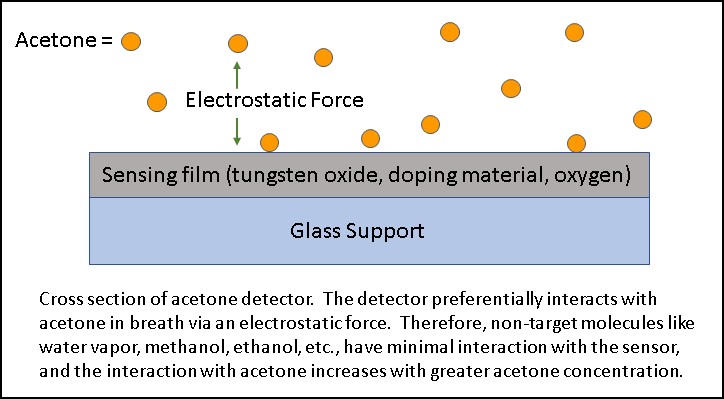Handheld Glucose Monitor Based On Acetone in Exhaled Breath – Reusable, Non-Invasive, Pain-Free, and Fast, for Diabetes, Pre-Diabetes, Weight Loss, and Athletic Training (RFT-573)
Invention Summary

Scientists at NDSU have developed a glucose monitor based on acetone in exhaled breath. The detection range encompasses normal through diabetic glucose levels, enabling versatility to monitor blood glucose in diabetic and pre-diabetic individuals, as well as tracking diet and athletic performance. Results are obtained in seconds, with the acetone concentration providing a direct indicator of blood glucose. The correlation between breath acetone and blood glucose is well known, but the ability to build this capability into a handheld device has been a hurdle. The NDSU sensor is very small, suitable for a handheld device, but with excellent accuracy and precision. Data may be compiled to provide a history (e.g. integration into a diabetes wellness app), while also providing immediately actionable information (e.g. blood sugar status). The acetone detector consists of semiconducting nanomaterial that includes tungsten oxide, a doping material, and oxygen, and requires no needles, patches, or other skin contact. The sensor operates across normal ambient temperature ranges. Sensitivity achieved to date is 0.5 ppm acetone, with resolution to 0.05 ppm. Ongoing research is aimed at achieving this sensitivity in the presence of water vapor and other molecules (e.g. methanol) that are present in exhaled breath. The sensor can be miniaturized to about 1 cm3, with the detector portion as small as 1 mm across. The detector has essentially unlimited reuse potential, as long as it is maintained and cared for properly.
Benefits
- Completely non-invasive and painless, no needles, patches, clamps, or other skin contact
- Can be calibrated to each individual, and once calibrated provides a highly sensitive and accurate indirect measure of blood glucose that can be used to determine (for example) whether supplemental insulin is needed
- Detects down to (0.5 +/- 0.05) ppm acetone, which differentiates between diabetic, pre-diabetic, and non-diabetic for wellness monitoring, and provides enough resolution to determine whether insulin is required
- Calibration, materials, and structure minimizes the impact of non-target molecules such as water vapor, methanol, ethanol, etcetera
- Reusable hundreds of times, minimum lifespan without additional surface clean-up expected to be 6 months.
- Very compact, small enough to fit into a mobile device
- Promising economics and scale up, based on long lifespan and very straightforward manufacturing process using readily available materials
Patents
This technology is patent pending in the U.S. and is available for licensing/partnering opportunities.
Contact
NDSU Research Foundation
info@ndsurf.org
(701)231-8173
NDSURF Tech Key
RFT, 573, RFT573
Inquire about this technology >